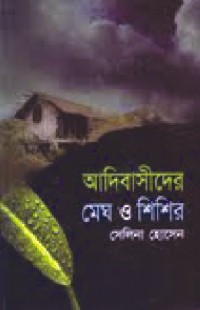|
Book Review
The Tales of the Neglected
Jackie Kabir
 |
Adibashider Megh O Shishir
Selina Hossain
Publisher: Mawla Brothers |
Adibashider Megh O Shishir is a collection of four short stories, four essays, a novella for children and a travelogue, all of which are written on the backdrop of adivashi lives. There are numerous characters, real and imaginary that the author depicts with utmost sincerity.
The first story, Bonobhumi, is about an indigenous girl who was kidnapped by the army living in the hill tracts of the southern area of Bangladesh. The same people in the area abused her mother when she was only ten years old. Chandana would vent out against their wrongdoings in her diary everyday, and revolt by supporting the anti-government candidate in the election. She knew that her mother was raped brutally in the jungle, even despite her father's protests. He burnt the boot of the rapist, which he had left behind in a hurry. As such, the bootlace becomes a symbolic rope for the eventual hanging of the hill-tract girl. The lieutenant of the camp nearby was interested in Chandana. However she despised him and after she displayed her hatred for him in public, she was abducted. She was never to be seen again and no one could even trace her remains.
Darkak is a sad story about an Abdul Mannan who was called 'Mouna' by people. Losing his name in the whirlpool of poverty, Mouna didn't have any land of his own. Getting tired of not being able to feed himself and his family, he takes the offer of moving to the hill tracts to become one of the settlers. He begins to dream of starting a new life at the age of forty-three. As he is about to commence this new life with his new wife in an unknown land, the Shantibahini attacks and burns everything down. He is seriously injured and his body gets burnt and deformed to such an extent that it almost looks like the skeleton of a bird.
Polatok Rong revolves around a young Bengali boy who goes to visit the hill tracts. His friend and his host, was a native of the area. Amazed by the beauty of the place, he is awestruck by the lives of the people there. At the same time, he is shocked to find how vulnerable their lives were and how much they suffered from the maltreatment of their fellow Bangladeshis. One day the girl from his host family is raped and he is accused and punished for the crime. That is when he realises that the Adibashis and Bengalis can really never be friends.
The novella, Ek Rupoli Nodi, is about a group of monks who flee the hills of South Eastern Chittagong after Bengali settlers invaded their monastery. It's a sad tale focusing on their journey towards the Myanmar border. Many of them don't make it to the other side as they travel barefoot and hungry for weeks. Some of them reminisce about their past, about how happy they were in the monastery. Leaving one's motherland is not an easy job for anyone. But still, they do it in the hope of returning to their motherland some day in the future.
The travelogue 'Parbotto Bhumir Pothe Prantore' is more like a research work. It covers everything from the report of the Amnesty International on the Peace Treaty to the submerging of King Debasshish Roy's residence by the Karnaphuli Dam. Selina Hossain explains in her writing her desire to write a novel depicting the lives of hill tract people. Her daughter Lara was with her then, and she writes in detail of their travel adventure in the essay. Rangamati was known as the 'Land of God' because of its natural beauty. Bengalis started living there since the 19th century but were banned from the area in 1860s. In 1866 the Mughal King Aurangzeb took the hill tracts under his wing. Then in 1760, the East India Company took control of it with the rest of Bengal. It was not until 1785 when the people accepted the Peace Treaty, that they could rule the hill tracts. However, the Shantibahini couldn't bring them the peace that they wanted or needed. They were against using the word “Upojati” and would rather be called “Pahari.” They were also against using the word “Oupjati” for the Bengalis living there and the list could go on. To summarise, Selina Hossain talks in detail about her visit to the three hilly districts, the feelings of both Bengalis and paharis regarding the peace treaty and how it had affected their lives. The more she talked to them the more amazed she became. The essay of around 200 pages could stand as a book on it's own.
Adibashider Megh O Shishir is a highly recommended book for all Bangladeshis to read as it reveals the tale of people who live under the same sky as ours but yet remain almost unknown to us.
Copyright
(R) thedailystar.net 2010
|

